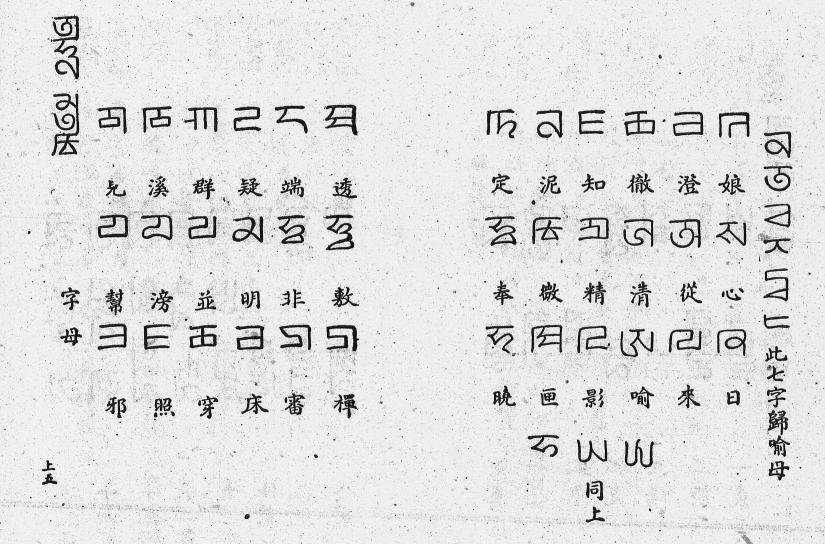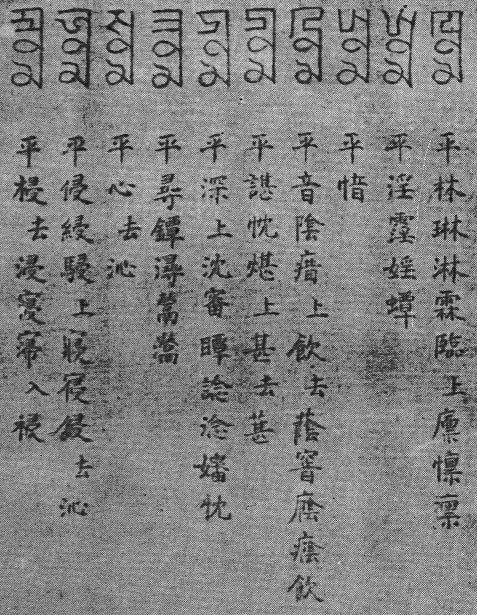BabelStone Blog
Saturday, 23 December 2006
Phags-pa Alternate Letters YA, SHA, HA and FA
After having discussed the basics of Phags-pa Shaping Behaviour, I thought it would be a good idea to discuss one final piece of essential Phags-pa knowledge before moving on to other things in the new year. That is, the four "alternate" letters for YA, SHA, HA and FA used in one particular Chinese Phags-pa text :
- U+A86D ꡭ PHAGS-PA LETTER ALTERNATE YA
- U+A86E ꡮ PHAGS-PA LETTER VOICELESS SHA
- U+A86F ꡯ PHAGS-PA LETTER VOICED HA
- U+A870 ꡰ PHAGS-PA LETTER ASPIRATED FA
The Yuan dynasty rhyming dictionary Menggu Ziyun 蒙古字韻 is one of the most important Phags-pa texts, as it gives the pronunciation in Phags-pa script for over 9,000 Chinese characters. However, the author (or editor of the only extant 1308 edition) attempts the impossible task of reconciling the pronunciation of the proto-Mandarin Chinese spoken at the time with the traditional phonetic classification of Chinese into thirty-six initials that had been developed during the Tang and Song dynasties several hundered years earlier.

As there was no longer a one-to-one correspondence between the historic thirty-six initials and the contemporary pronunciation, Menggu Ziyun uses variant forms of some letters to represent the contemporary Yuan dynasty pronunciation and at the same time maintain the historic phonetic distinctions of the traditional "thirty-six letters". The situation is rather complicated, and I won't go into details here (read here if you are interersted), but I'll summarise the relationship between the historic thirty-six initials and Phags-pa letters in the table below.
| Historic Initial | Phags-pa Letter | ||||
|---|---|---|---|---|---|
| Number | Example Character |
Phonetic Value |
Letter | Unicode Value |
Phonetic Value |
| 1 | 見 | k | ꡂ | U+A842 GA | g |
| 2 | 溪 | kʼ | ꡁ | U+A841 KHA | kʼ |
| 3 | 群 | g | ꡀ | U+A840 KA | k |
| 4 | 疑 | ŋ | ꡃ | U+A843 NGA | ŋ |
| 5 | 端 | t | ꡊ | U+A84A DA | d |
| 6 | 透 | tʼ | ꡉ | U+A849 THA | tʼ |
| 7 | 定 | d | ꡈ | U+A848 TA | t |
| 8 | 泥 | n | ꡋ | U+A84B NA | n |
| 9 | 知 | ȶ | ꡆ | U+A846 JA | dʑ |
| 10 | 徹 | ȶʼ | ꡅ | U+A845 CHA | tɕʼ |
| 11 | 澄 | ȡ | ꡄ | U+A844 CA | tɕ |
| 12 | 娘 | ȵ | ꡇ | U+A847 NYA | ȵ |
| 13 | 幫 | p | ꡎ | U+A84E BA | b |
| 14 | 滂 | pʼ | ꡍ | U+A84D PHA | pʼ |
| 15 | 並 | b | ꡌ | U+A84C PA | p |
| 16 | 明 | m | ꡏ | U+A84F MA | m |
| 17 | 非 | f | ꡤ | U+A864 FA | f |
| 18 | 敷 | fʼ | ꡰ | U+A870 FA | f |
| 19 | 奉 | v | ꡤ | U+A864 FA | f |
| 20 | 微 | ɱ | ꡓ | U+A853 WA | v |
| 21 | 精 | ts | ꡒ | U+A852 DZA | dz |
| 22 | 清 | tsʼ | ꡑ | U+A851 TSHA | tsʼ |
| 23 | 從 | dz | ꡐ | U+A850 TSA | ts |
| 24 | 心 | s | ꡛ | U+A85B SA | s |
| 25 | 邪 | z | ꡕ | U+A855 ZA | z |
| 26 | 照 | tɕ | ꡆ | U+A846 JA | dʑ |
| 27 | 穿 | tɕʼ | ꡅ | U+A845 CHA | tɕʼ |
| 28 | 床 | dʑ | ꡄ | U+A844 CA | tɕ |
| 29 | 審 | ɕ | ꡮ | U+A86E SHA | ɕ |
| 30 | 禪 | ʑ | ꡚ | U+A85A SHA | ɕ |
| 31 | 曉 | x | ꡜ | U+A85C HA | h |
| 32 | 匣 | ɣ | ꡣ ꡯ |
U+A863 XA U+A86F HA |
x h |
| 33 | 影 | ∅ | ꡖ ꡗ |
U+A856 -A U+A857 YA |
ʔ j |
| 34 | 喻 | j | ꡝ ꡭ |
U+A85D 'A U+A86D YA |
∅ j |
| 35 | 來 | l | ꡙ | U+A859 LA | l |
| 36 | 日 | ȵʑ | ꡔ | U+A854 ZHA | ʑ |
Notes
- The phonetic values of Initials 9-11 had converged with Initials 25-27 by the Yuan dynasty, and are not distinguished in MGZY
- The phonetic values of Initials 17-19 had converged by the Yuan dynasty, and are distinguished in MGZY by two forms of the letter FA. It may be that the original text of MGZY used three forms of the letter FA, but textual corruption in the only extant version of the book (an 18th century manuscript copy of a copy of ... the original 1308 printed edition) has obliterated the distinction; or it may be that because all three initials never occur with the same final, there is never any need to distinguish between more than one particular pair of the three historic initials for any given syllable, so two forms of the letter FA are sufficient.
- The phonetic values of Initial 29 and Initial 30 had converged by the Yuan dynasty, and are distinguished in MGZY by two forms of the letter SHA.
- The phonetic values of Initial 31 and Initial 32 had partially converged by the Yuan dynasty, so that the Phags-pa letter HA is used for Initial 31, and also for Initial 32 before the semi-vowel /j/ and front vowels excluding /i/, but the Phags-pa letter XA is used for Initial 32 before back vowels and /i/ (i.e. occurences of HA and XA are mutually exclusive).
- The situation for Initial 33 and Initial 34 is complicated and not entirely clear. Both Phags-pa letter -A ("Small A") and the normal form of Phags-pa letter YA are used for Initial 33 (historic null initial); whereas as both Phags-pa letter 'A (the null consonant) and a variant form of Phags-pa letter YA with a trumpeted bowl are used for Initial 34 (historic palatal initial).
Page from Menggu Ziyun

- DZIM ꡒꡞꡏ 梫 etc. (historic *tsĭěm)
- TSHIM ꡑꡞꡏ 侵 etc. (historic *tsʼĭěm)
- SIM ꡛꡞꡏ 心 etc. (historic *sĭěm)
- ZIM ꡕꡞꡏ 尋 etc. (historic *zĭěm)
- SHIM1 ꡮꡞꡏ 深 etc. (historic *ɕĭěm)
- SHIM2 ꡚꡞꡏ 諶 etc. (historic *ʑĭěm)
- -IM ꡖꡞꡏ 音 etc. (historic *ĭěm)
- YIM1 ꡗꡞꡏ 愔 etc. (historic *ĭěm)
- YIM2 ꡭꡞꡏ 淫 etc. (historic *jĭěm)
- LIM ꡙꡞꡏ 林 etc. (historic *lĭěm)
In summary, MGZY uses two different forms of each of the letters YA, SHA, HA and FA to represent historic phonetic differences for some syllables that were phonetically identical in Yuan dynasty proto-Mandarin. These glyph differences are not normally seen in other Yuan dynasty Chinese texts and inscriptions in the Phags-pa script; that is to say, in most extant Chinese Phags-pa texts other than MGZY only a single form of the letters YA, SHA, HA and FA are found, regardless of the historic phonetic value of the word that it occurs in. Thus, the use of the four characters U+A86D ꡭ, U+A86E ꡮ, U+A86F ꡯ and U+A870 ꡰ should normally be restricted to contexts involving MGZY.
And for those of you interested in historical Chinese phonetics, one of my projects for the spring is to produce an electronic version of the complete text of Menggu Ziyun.
Index of BabelStone Blog Posts